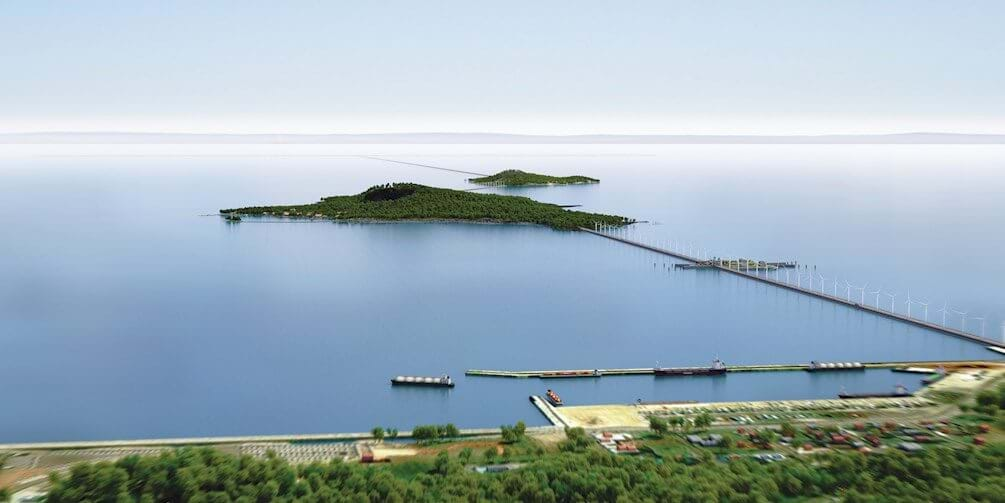Dynamic Tidal Power: An Amazing Reliable Energy
A Massive Amount of Energy Just Waiting To Get Collected

Unlike solar power and wind energy, dynamic tidal power is a more predictable renewable energy that is readily available to us.
Since the tidal cycle is both predictable and repetitive, this allows us to estimate the amount of continual power that we can generate by tidal energy in different geographical locations.
We can determine tidal movements since they get based off of trackable planetary forces(like the moon).
The U.S and U.K have said that tidal technology could produce up to 20 percent of their future electric consumption.
China has also started to heavily invest in the tidal power sector again to help them meet their ever-growing power demand.
A major benefit of these countries doing this is that it helps them cut their dependence on imported fossil fuels.
Early studies conducted by China are showing that a large DTP dam set up along the Chinese cost will have the potential of producing 5000MW or more. They are making it one of the worlds biggest hydropower projects.
Dynamic tidal power has a good efficiency for power generation.
According to current research, dynamic tidal power could also have a smaller environmental impact than other tidal generation methods.
Several locations in North America also have exceptional energy production capabilities. Specifically, the coasts of Alaska, British Columbia, Washington, and Maine are prime areas for tidal wave power generation to get placed.
The idea behind dynamic tidal power is quite simple. And apparently, it is very similar to what we have been using in our hydropower plants(using water to move a turbine).
How Does Dynamic Tidal Power Work
Dynamic Tidal Power Video
Dynamic Tidal Power Diagram

Dynamic tidal power is a new concept possible now, thanks to advances in technology for clean, renewable energy.
Best of all is that it works according to a completely different principle compared to our traditional tidal barrage system.
While dynamic tidal power still uses dams, and their original implementation was massive structures that could extend quite far into the open sea.
These Dams would run 30 to 60 km long and get mounted perpendicular to the coastline. The dam will usually get engineered into the shape of a "T" or "Y".
Potential energy gets created by the dam interfering with the oscillating tidal waves. The oscillating tidal waves then create a height difference between the water levels on each side of the dam. They have been designed to take advantage of the tides that run parallel to the shore.
DTP also takes advantage of the acceleration forces of the tides instead of just relying on the kinetic energy created by the water height difference.

By using newer low head turbines created for use in tidal range applications, we can now efficiently convert this potential energy into usable electricity.
These conventional bi-directional low-head turbines get installed within the actual dams. They are designed to produce energy regardless of the direction of the tide.
Newer research is already looking into designing smaller DTP structures and placing them in waters where there is immense dynamic tidal potential.
While these smaller structures will produce less power, we can overcome most of these loses quickly.
The research showed that by placing multiple smaller structures instead of a superlarge one, we can further limit the environmental impacts while still generating large amounts of energy.
The Pros and Cons of Dynamic Tidal Power
Advantages of Dynamic Tidal Power
Dynamic tidal power will provide more continuous power generation than many other renewable energy sources.
It can be set up to produces energy regardless of what direction the tides are moving in.
The movement of the tides is constant and much more predictable than other renewable energy sources we are currently using. This consistency is what makes tidal power a continuous energy source.
Unlike most of our traditional power generation, which burns fossil fuels to turn turbines with steam, and results in high output levels of CO2 getting released into our atmosphere.
Tidal energy, on the other hand, uses the tides of the water to spin turbines without the creation of any CO2.
Dynamic Tidal Energy Availability
DTP is available to many more locations compared to our original tidal wave energy techniques. The traditional methods required large tidal ranges with at least a 7-meter difference to generate any reasonable amount of power.
Needing large tidal ranges limited the areas where we could build up our tidal energy systems.
Thanks to all the improvements in turbine technology over the last decade like new axial turbines and cross-flow turbines.
We have significantly increased the number of areas where we can now generate electricity with the use of tidal power technology.
Early research is showing that DTP should also result in less environmental issues than older wave generation technologies.
We can also combine these systems with others like systems to protect us from waves and tsunamis, deep seaports, and even connections between islands and the mainland. China is placing wind turbines on top of their dams to maximize green energy production while conserving space.
Estimates beleive that the larger dams in Europe could be able to accommodate over 15000 MW of installed capacity. These large capacities will allow DTP technology to provide enough power to supply energy to millions of people.
Disadvantages of Dynamic Tidal Power
The first problem has to do with the fact that dynamic tidal power is such a new technology and is still, for the most part, untested.
While small tests have shown positive results, we still need this technology to get tested on a larger scale to see how much more beneficial it is.
We still do not fully understand the ecological impacts of placing a 30 to 60 km dam blocking off extensive lengths of costal flows in our waters.
Altering these flows could result in us interfering with migration patterns, mating patterns, and many others.
While original tidal wave technology did not create any CO2 emissions, the construction of the basins getting used has been linked to large changes in tidal flows.
These changes can result in a negative impact on our aquatic and shoreline ecosystem.
Depending on the local geography, these tide changes could result in significant damage and would need to get analyzed on a site by site basis further increasing the cost of the project.
To build a 30 km dam and place it out in the ocean has many engineering difficulties that need to get worked out.
These projects also require a significant backing investment. Generating the capital is difficult since we are still not 100% certain that it will work as efficiently as we believe/hope.
The turbines used in DTP spin at a faster rate than many other forms of tidal technology, this creates another hazard for our aquatic life. Faster turbine movement requires additional equipment to get set up to keep the marine life safely away from the blades.
The last thing we want is for these devices to begin getting clogged up with marine life. Also, I don't think marine life would be too pleased with that outcome either.
Why Switch to Dynamic Tidal Power?
The primary problem with our original tidal wave power generation methods is the significant height difference between high tide and low tide(tidal range) that is needed.
But with Dynamic tidal power generation, no basin(partially human-made reservoir) or large tidal ranges are required any longer to generate power efficiently.
The Sihwa Tidal Power Plant that is in Korea has one of the highest generating capacities at 254 MW. They are using the older tidal range technology.
Even after taking advantage of an existing causeway that was initially used for flood defense and agricultural purposes, the project came to an estimated cost of $298m. The unbelievable price for engineering these basins was the primary reason for the slow adoption of tidal power.
You May Also Like
25 Pros and Cons to Wave Energy18 Pros and Cons of Hydroelectric Energy